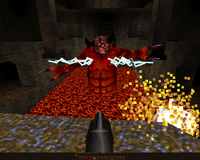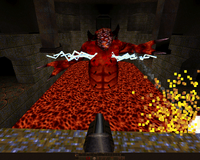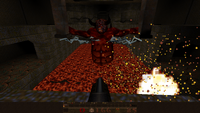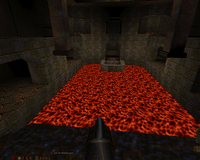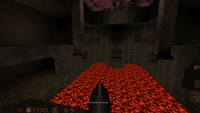![]()
Source ports are modifications of a game's source code that add extra features, such as improved graphics and support in newer operating systems. For Quake, source ports also allow you to play Quake without having to run the game in DOS or a DOS-emulating program like DOSBox.
The term Source port comes from source code as after the release of the specific game's source code by the developers, third party developers and progammers began to create their own engines for the main game.
Quake
Before the public release of the source code by Id Software ports were developed with license from the developers, Dave Taylor one of the employees of the company at the time developed the first ever port to the Linux operating system on July 5, 1996. Later followed by a Sparc Solaris port later at the same year.
A Mac OS port was also released, being the first commercially released port done by MacSoft and Lion Entertainement. Dated late August 5, 1997. ClickBOOM developed a port of the game to the Amiga operating system in 1998.
One of the oldest known Source ports entitled VQuake was developed by John Carmack, designed for use with the Redition Verité V1000 chipset on late 1996. The port predates the more known GLQuake by one month, John Carmack however feeling frustated by Verité's progamming difficulties, gave up on the Verité focusing on support for non-proprietary API's.
Officialy released Source ports
GLQuake was developed by Id Software, being released to public on January 22, 1997. It is one of the most known Source ports and many of the modern GL Source ports derivate from it. Unlike the vanilla renderer GLQuake allowed for advanced graphic features such as linear filtering on textures, shadows, transparent liquids, improved speed, reflective surfaces. The changes are quite controversial among the community though, for example some may feel the textures lose their detail when filtered, GLQuake also lacked graphical features present in the original renderer such as overbright lightning and fullbrights on textures, which made the maps way darker than they were meant.
WinQuake, a Source port which allowed the game to be played on modern Windows operating systems with the original renderer, was released later on the same year. Being faithful to the original game's look. QuakeWorld only version was later released.
QuakeWorld was later released focusing on improving the multiplayer aspect of the game, QuakeWorld received both software and GL versions.
Un-official Source ports
See: List of Quake Source ports
After the release of the Quake Source code on 1999, third-party progammers began to create different engines so the game could be played on modern operating systems. Some focusing on getting the game to run straight, without any graphical enhancements, others introducing in some graphical features such as particles, improved rendering, colored lightning, real time shadows, support for texture and model replacements and more.
Official Source ports comparison
Multiplayer Only
Quake 2
See: List of Quake II Source ports
As with the first game, Quake II received a number of fan made third-party Source ports after the release of the game's source code on 2001. However unlike the first game, Quake II didn't receive official Source ports by Id software themselves, the main reason being the original engine already supporting both Software and OpenGL rendering running on Windows, thus the need for a update was scrapped.
The advantages of using an modern Source port for playing Quake II can range from bug fixing and addition of new features without altering the visuals, or improved graphics and rendering while fixing bugs. Some source ports also allow external music to be played without a CD in the drive.
Quake 3 Arena
Source code released in 2005.
Quake 4
The source code to Quake 4 was never released, but the source code to the id Tech 4 engine and Doom 3 were in 2011.
- Quake4Doom (main thread, additional thread)
- gbQuake4
- Quake4-for-EGL Wrap-AmigaOS4 (article, news post, thread)
- idTech4A++ (Harmattan Edition) (thread, video)
The author of Quake4Doom has also drafted a similar port for Prey, but not Enemy Territory: Quake Wars which uses an updated version of id Tech 4.
External links
- Quake Engines & Source Ports: A Beginners Guide
- The Big List of Quake Engines
- Features of Modern of Source Ports
- Quake - Source Ports - GOG Support Center
- Quake 2 - Source Ports - GOG Support Center
| Quake | ||
|---|---|---|
| Characters | Ranger · Quake | |
| Enemies |
Death Knight · Enforcer · Fiend · Grunt · Knight · Ogre · Ogre Marksman · Rotfish · Rottweiler · Scrag · Shambler · Spawn · Vore · Zombie | |
| Bosses | Chthon · Shub-Niggurath | |
| Barriers and Hazards | Button · Door · Electric Terminal · Falling Spike · Guillotine · Lava · Laser Trap · Movable Wall · Nail Trap · Radioactive Container · Slime · Spiked Sphere · Teleporter · Unholy Altar · Water · Wind Tunnel | |
| Level Exits | Arch · Exit Gate · Rune Gate · Slipgate | |
| Powerups | 15 Health · 25 Health · 100 Health · Armor(Green)(Yellow)(Red) · Biosuit · Key · Pentagram of Protection · Quad Damage · Ring of Shadows · Rune | |
| Weapons | Axe · Shotgun · Double-Barreled Shotgun · Nailgun · Super Nailgun · Grenade Launcher · Rocket Launcher · Thunderbolt | |
| Ammo | Backpack · Shells · Nails · Rockets · Cells | |
| Source ports | GLQuake · GLQuakeWorld · QuakeWorld · VQuake · WinQuake | |
| Other | Crate · Dopefish | |

